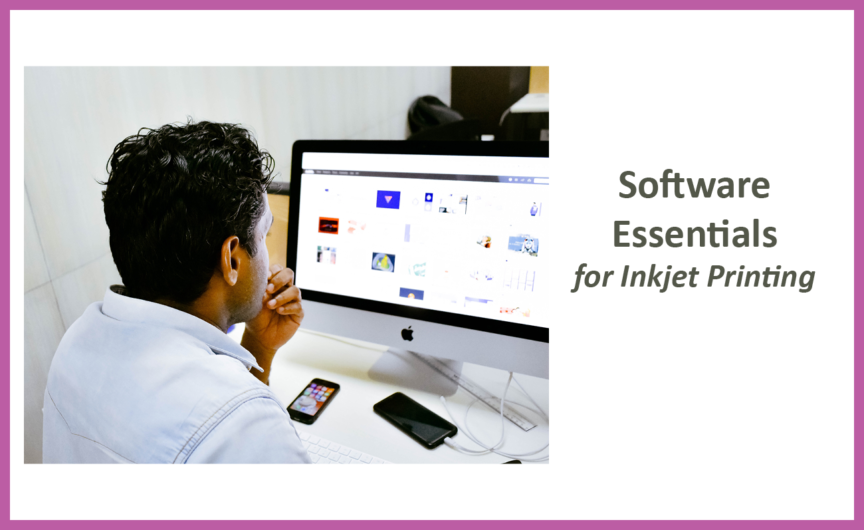During Inkjet Innovation Week, Elizabeth Gooding and I talked about essential software for your inkjet ecosystem, with an understanding that some environments look for end-to-end automation, while others look for tools to help them build a workflow that meets their business needs. Consider that that every business has at least two workflow environments: a business workflow and a production workflow.
The business workflow is the home of the processes involved in Accounting, Business Intelligence, HR management, and the basics of running the business. There are often business analytic tools, accounting tools, and a variety of common office tools, including spreadsheet and communication tools. The crossover between the business process and production processes might be a print Management Information System (MIS) or a generic business MIS; it may be spreadsheets and email.
The production workflow is home to the tools that take the file delivered by the client or creative team in the graphic arts department and moves it through on-boarding, color management, and preparation for print. These tools also capture information about the jobs and often feed data back to the business systems. Tools in this set may also automate functions and provide tracking and handle scheduling. There are dozens of touchpoints in a production workflow, and there are tools that touch each one. In some organizations, there is an end-to-end workflow acquired from a single vendor that forms a framework for automation of many functions. In other businesses, the workflow is crafted from hand-picked tools that guide the work.
In both types of workflow, there can be a distinct advantage to automation, especially in the fast-paced inkjet printing environments. But, automation can mean many different things, so here is a quick guide to looking at automation for your environment.
Automating Job OnBoarding
There are as many ways to bring a job into your shop as there are salespeople and customers. When you add the many web-to-print solutions (and there may be two or more in many companies), there are more permutations than a Rubik’s Cube. The challenge in the shop is that for every path a job might take in the door there are variations on the information captured. W2P solutions, if well-programmed, can be amazingly consistent in capturing information. The trick is to not allow submission unless valid entries are in all fields and to require an alternate form if the job has custom needs. But, every salesperson is likely to have a different set of things they think are important. And for certain customers they may thing one set of criteria is important, while a different set are important for other customers. That leaves the customer service teams to clean up the specifications. Jobs that are contractual – they come in as reorders of a set job – have their own challenges. If substrate availability is lacking or there has been some other production change, the CSR is back to chasing a customer to resolve the challenges.
There is no way to eliminate the many things that can happen in job onboarding, but the more you standardize, the better it is for everyone. The solution may already exist in-house, and this is a great time to do to the homework. If you have a web-to-print solution, or several of them, can it become your onboarding portal for all of the sales team members and any contract work, as well as how you use it today? The answer is often “Yes!”
If you don’t have a W2P environment stood up, look at your other workflow solutions to see if they include features and functions that will help you to standardize how you bring the jobs in. The goal is to capture the specifications, confirm the inventory needed, scheduling for print and finish, and the delivery time frames, along with the quoted cost. Keep that in the front of your mind.
Once you have the job, remember that sometimes those jobs need changes. What is your change management system? It should be integrated into your overall workflow to ensure that changes are paid for!
Automating Once the Job is OnBoard
There is a vast landscape of automation options for print shops. Workflow automation tools like Prinergy and OneVision in the commercial space, and tools like Solimar Rubika and SPDE, Crawford’s PRO series, Sefas and others in the Transaction and DM space provide options to automate some or all of your workflow. If you have any of these systems installed, book a call with the vendor and start talking to them about automation. They can help!
You should be asking them about rules-based automation that customizes the flow of work to your needs, and you should be asking them about how to maintain workflows once they are automated. They can help you with low code/no-code scripts and rule building, and they can provide references! Ask them hard questions about your most difficult manual workflows, and be open-minded because there may be some things worth changing to bring you more efficiency.
Before you make any final decisions, consider calling vendors you aren’t working with and listen to their pitch. On any given day there are new features and functions coming to market and one of them might be just what you need.
Your take-away should be to set up an assessment of your current job onboarding environment to get your arms around it. Do the homework so that when you are ready to engage with your vendors you will have all of the information you need!
Remember, there are a million questions in inkjet city! Have a question for Pat? Contact us.

